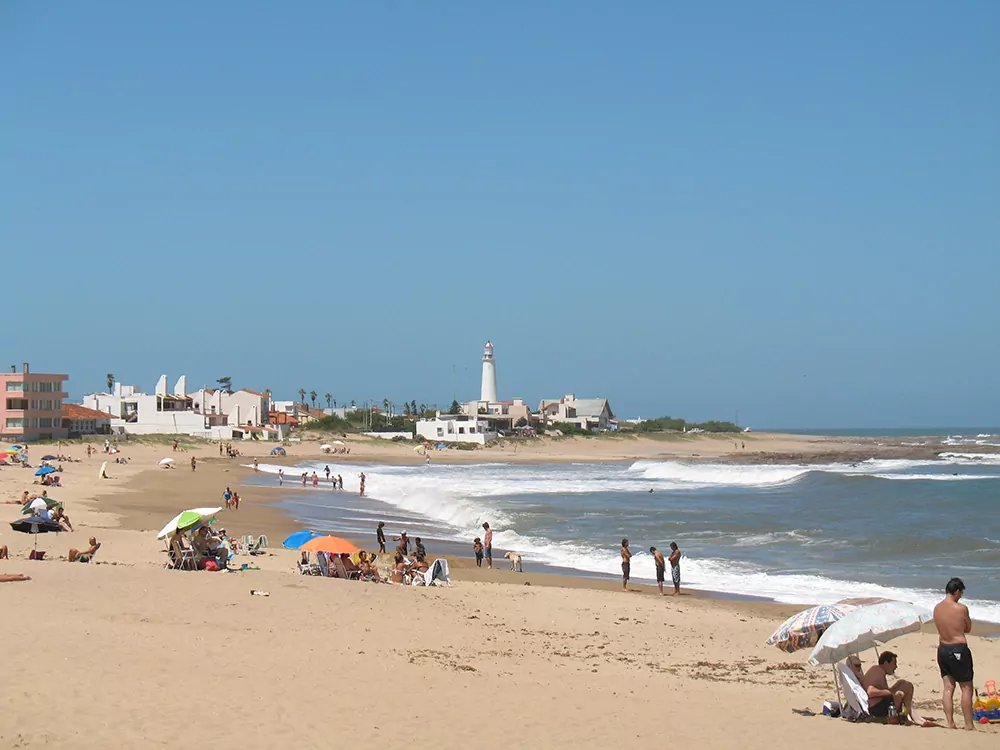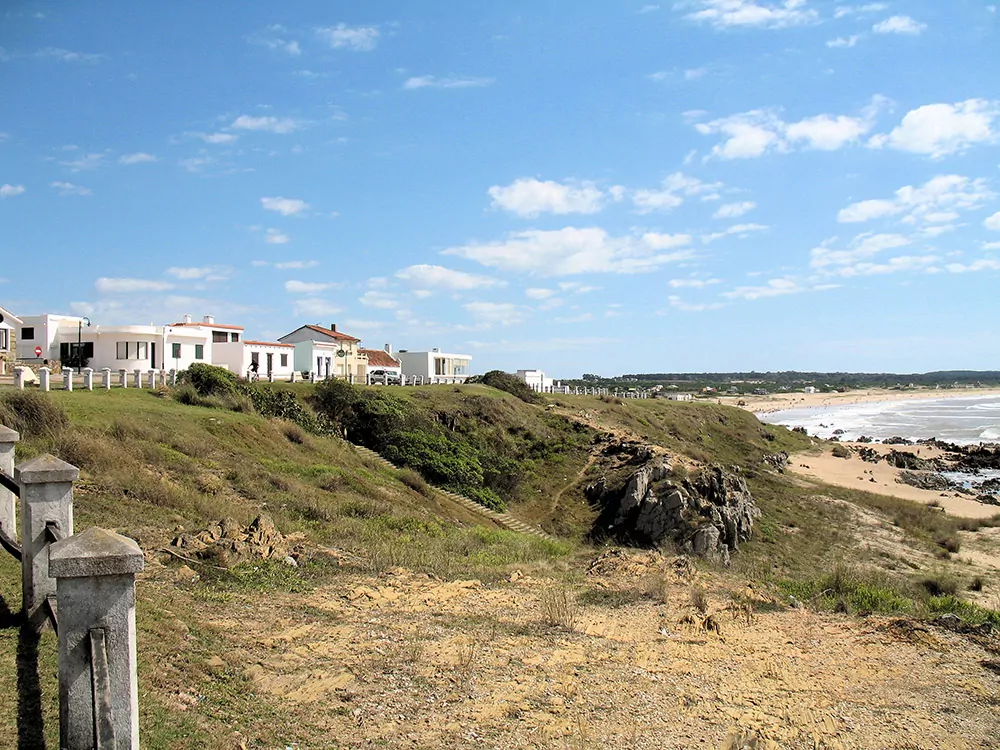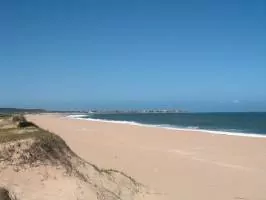July 21, 2015
La Paloma, Uruguay
Property in Uruguay trades in U.S. dollars
Dear Overseas Property Alert Reader,
There’s one affordable section of coastline left in Uruguay that still boasts miles of undeveloped, pristine beaches with fine white sand bordered by deep blue Atlantic waters. There are no high-rises, few developments, and almost no one on the beach. This 100-mile stretch of coastline is in the department of Rocha.
Rocha is the next big thing in Uruguayan beach real estate… and likely the last big thing.
There are a few market forces at work in Rocha.
The first is the need for developable land. During the 11 years since I first explored the area, the path of development has marched relentlessly up the coast, from the posh resort of Punta del Este toward Uruguay’s border with Brazil. Through good times and bad, the financing has continued for new developments and the demand has continued for new vacation homes.
Today, the department of Rocha is the last frontier… although, it’s not undiscovered by developers. The first few high-end developments are underway and selling well.
 |
|
The beaches in Rocha are second to none |
While the developers may be creeping up the coast from the direction of Punta del Este, the second market force is coming down from the north: Brazilians. Thousands of Brazilians are driving right through Rocha every year on their way to Punta del Este. And, as the luxury developments in Rocha continue to become more popular, many Brazilians are deciding to simply stay in Rocha to enjoy its slower pace, smaller crowds, and lower prices.
And, aside from the need for land and the traffic from Brazil, there’s one more market force at work here: cost. You can still buy for less in Rocha, while enjoying the country’s best beaches and avoiding the crowds of the more popular resort areas.
Rocha: Lower Prices And More Tranquility
Rocha has four seasons, as does all of Uruguay. The summertime (December through February) will see temperatures around 85 degrees Fahrenheit, and the winter will usually see highs in the 50s. Overnight freezing temperatures are rare, and there’s no snow. For example, today’s high, in midwinter—July 17—was 62 (16 degrees Celsius), and it’s going down to 43 tonight (6 Celsius)… a warm day by wintertime standards.
This part of the Atlantic coast is mostly rural, but it is home to a few coastal villages and towns. These include a couple of small resort destinations—La Paloma and La Pedrera—each with its own distinct character, clientele, and real estate market.
Let’s take a look at what La Paloma and La Pedrera have to offer.
La Paloma: Bright, Bustling, And Cheerful
La Paloma is an energetic, pleasant beach town of about 5,000 people. It’s one of the oldest settlements in the region and was actually a port city many years before anyone was thinking of seaside resorts in the area. The first registered ship arrival was on Jan. 9, 1520, and the small port is still in use today. As recently as 1874, the only public place to stay was in the guest quarters of its signature lighthouse. Visitors arrived by sailing vessels because there were no roads.
 |
|
La Paloma enjoys a festive atmosphere throughout the summer |
La Paloma comes to life in the summertime, with the peak season beginning Christmas week. People come mostly from Argentina and Montevideo, supplemented by a fair number from Brazil and even North America. They’re here to enjoy the magnificent weather, sidewalk cafes, fine restaurants, and the smell of grilling barbecues in the air. All the while, the beaches remain surprisingly uncrowded when compared to Punta del Este.
 |
|
One of La Paloma’s beaches, uncrowded even in peak season |
The only downside of La Paloma is that summer doesn’t last all year. And, in the wintertime, many of the shops are closed and almost all the people are gone (some consider the latter a good thing). Enough of the stores and eateries remain open to live here, but not much more.
La Pedrera: Quieter, More Refined, And More Exclusive
The New York Times recently referred to La Pedrera as “South America’s next bohemian-chic hideaway.” The term “bohemian-chic,” of course, instantly adds to the pricetag of any market. But, in truth, they’re right… La Pedrera has for years been a smaller, more refined, and exclusive version of La Paloma. It does not have La Paloma’s festive atmosphere or the number of shops and restaurants, but many visitors and homeowners appreciate the quieter, low-key atmosphere in La Pedrera.
 |
|
The chic La Pedrera enjoys cliffs, rocky shores, and sandy beaches |
Unlike La Paloma, La Pedrera has some rocky cliffs at the water that provide amazing ocean views. And the town itself is built on a hill, so even houses that are set back from the water have a good ocean view.
The Magnificent And The Humble
Most of the properties sold in this area are single houses rather than condos or planned community properties.
But there are a few planned communities. A number of international developers are now beginning projects in the La Paloma-La Pedrera area in order to satisfy the demand of a growing number of buyers. This big investment is a sure sign that the area is gaining in popularity and momentum.
The first developer to invest in the area with a major project was Daniel Oks, of Argentina. I saw his seaside project called Tajamares de La Pedrera almost eight years ago, and it’s been quite a success. He followed Tajamares with La Serena Golf, another affordable quality project that’s still selling today.
There are also a number of high-end developments in the area. Noted developer Eduardo Constantini invested over US$60 million in the Las Garzas project nearby, where lots cost between US$150,000 and US$1 million. It’s got every amenity, and it’s a prestigious place to own a property.
On the local market, here are a few good buys in the area.
In the Costa Azul neighborhood of La Paloma, we found a small house of 94 square meters (1,010 square feet), with two bedrooms, two bath rooms, a covered outdoor barbecue area, garage, and storage shed. The port of La Paloma can be seen from the side gardens and kitchen. The asking price is US$125,000.
South of the port, in the Anaconda Beach area, there’s a 102-square-meter (1,100-square-foot) house on the market, with two bedrooms, two baths, and a large open living-dining-kitchen area with fireplace. Built in 2008, this house has nicely landscaped gardens surrounded by mature trees. The asking price is US$180,000.
There’s also a larger home we liked, in the Rincon del Rosario neighborhood. This one has a living space of 183 square meters (1,970 square feet) on two floors, with three bedrooms, three bathrooms, wooden perimeter fencing, garage, and wood-fired barbecue. The asking price is US$200,000.
In La Pedrera, we found a solid two-story brick house for sale, with 75 square meters (810 square feet) of living area, including two bedrooms and two baths. Built in 2007, the property has front and back yards, well landscaped for privacy, along with covered barbecue. Asking price is US$175,000.
In the center of La Pedrera, there’s an attractive wooden home on the market. Built on a raised wooden deck, the 90-square-meter (970-square-foot) house has large front and back decks, two bedrooms, two bathrooms, and is being offered nicely furnished for the asking price of US$135,000. It also comes with a wooden carport and covered barbecue area.
Is Rocha For You?
La Paloma and La Pedrera are smaller, quieter, and less pretentious than the more famous resorts of Uruguay. It’s somewhat removed from the bustle… but the area feels more isolated than it actually is. Rocha is still within three hours of the airport in Montevideo and about 90 minutes from Punta del Este.
Nonetheless, if you enjoy the energy, nightlife, and amenities of a world-renowned resort, then the towns of Rocha probably won’t be for you.
But, if you like the bustle and the cheerful atmosphere of a small seaside resort in the high season, then consider La Paloma or La Pedrera for a second home in the Southern Hemisphere. Prices are cheaper here than in Punta del Este, and the crowds are friendly.
Winter is quiet… but if you appreciate the cool weather, enjoy walking for miles on the empty beaches, and don’t mind the lack of humanity, then La Paloma or La Pedrera will be worth considering for full-time living as well.
Either way, I think the area still has a lot of upside potential for the property buyer.
Lee Harrison
Editor, Overseas Property Alert
Editor’s Note: You didn’t hear from me last Tuesday, and it’s worth an explanation. Lief Simon just locked down the terms of an agricultural investment with a projected 18% yield. The inventory is limited, and all of his previous agro-offers have sold out quickly.
Our internal protocol with small inventories is that readers of Overseas Property Alert get a chance at the offer first, before it goes to the general readership of Live and Invest Overseas.
This is not because you’re paying anything for Overseas Property Alert. It’s actually because of your high level of interest in the previous agro-offers.
When limited-inventory deals become available, our practice is to get the word out to you in the next available mailing slot… even if it’s my Tuesday slot. If you didn’t see the article, have a look here.
Lee,
My husband and I purchased 1 hectare in the mango plantation. Does that qualify us for a residency visa in Panama?
If so, can you please let me know where I can find the specific detail or steps we need to take to apply?
Thank you.
Cheryl
The Panama Friendly Nations visa requires that you establish “economic ties” to Panama, and your investment in the mango plantation should provide this tie if it’s titled in your name. There are other requirements for the visa… you can read the official requirements for the Friendly Nations visa here.
For further information, such as requirements, documents needed, and help with your visa application, we recommend contacting a lawyer.
Panama requires that you use a lawyer to get a visa, so, because you’re stuck with them anyway, I’d leave the legal interpretation to the lawyer and let them earn their money. With a good attorney, the process for getting this visa is easier than the documents above make it sound.
Lee,
I’ve been researching international retirement for over two years and have decided on Italy because of its rich culture, history, and warm and friendly people. My first choice is Abruzzo, followed by the regions around Puglia and Basilicata.
I hope to buy a small piece of land with fruit trees and area to grow crops, etc. I really want to continue working and believe the small farm will provide a substantial supplemental food source
I am anxious and eligible to retire from my Florida state job with a small pension of about US$1,200 a month. I just turned 62, and, combined with Social Security, I should have about US$2,300.00 a month.
I’ve also been thinking about taking the TOEFL certification exam to teach English and wonder just how easy it would be to get a teaching job, considering I’ve never taught before.
Rich
Editor’s Note: TOEFL (and TEFL) are certifications for teaching English as a foreign language.
In the areas that Rich has in his sights, you can indeed live a comfortable rural lifestyle on US$2,300 per month.
As to the small farm, my only caution would be to remember that making it productive will require a startup investment, and possibly a year or two of subsidizing its operating costs. In my experience, only seasoned farmers tend to make money farming abroad… but, for supplemental food, the bar is much lower than it is for making a profit.
For teaching English, I’ve found that certified individuals who are native speakers can usually find work, even without prior teaching experience. (My niece taught high school English in Ecuador with a TEFL certification and no prior experience.) Individual countries, however, have their own requirements, so you’d need to check on that.
Keep in mind, however, that you have to be in a population center large enough to have a demand for English instruction. This may conflict with the search for affordable farmland in a rural setting.
Have a question? You can write to Lee here.

